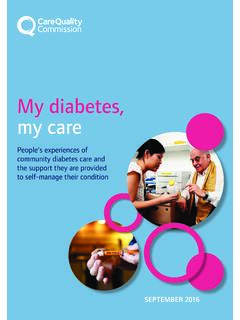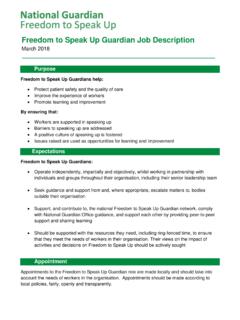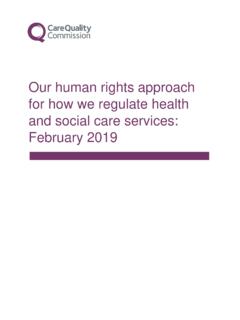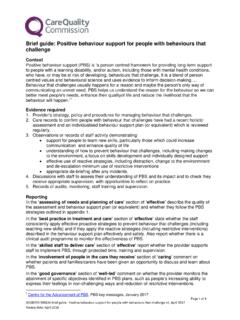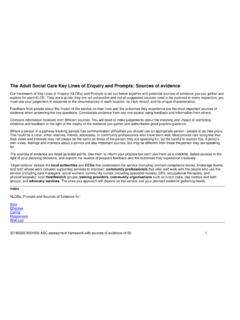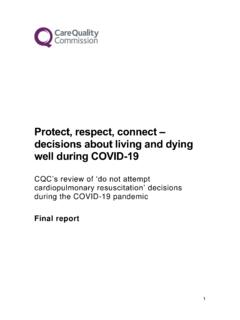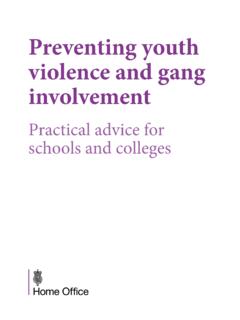Transcription of Residential key lines of enquiry (KLOE), prompts and potential …
1 20140924 Residential prompts with evidence column FINAL Page 1 Residential key lines of enquiry (KLOE), prompts and potential sources of evidence Introduction We have developed the key lines of enquiry (KLOEs), prompts and sources of evidence sections to help you answer the five key questions: is the service safe, effective, caring, responsive and well-led? The prompts and the sources of evidence are not an exhaustive list but are there to help you think about what you may wish to cover during the inspection process for an individual service. The prompts are questions; some are open and others closed. All of the prompts you use will need to have sufficient evidence underpinning them in order to be able to answer the KLOE itself and ultimately the key question they sit beneath.
2 The prompts should not be used as a checklist, and as you plan your inspection you may find that you do not need to cover all the prompts in each of the KLOEs. For example, you may identify evidence that confirms a particular prompt or prompts are already met. You may also find that some prompts do not apply to the type of service you are inspecting or that there is no indication that you need to cover a particular prompt to help you answer a KLOE. You can also develop your own prompts to help you answer the questions. However, in order to have sufficient evidence to reach a robust judgement, you must consider the amount and depth of evidence you will need to answer the KLOE, and the overall key question.
3 Developing a picture of the service, and its history, is an important part of your planning. It will help you focus on what you need to look at in more detail when you visit the service. This picture will also help you when you make judgements, using the characteristics of ratings, about the consistency of the practice you have seen in the service and their approach to ongoing improvement. You will need to be proportionate in how you assess the evidence for key lines of enquiry for smaller services or particular types of service, as they may not have the supporting infrastructure or complexity of systems that you may find in a larger service.
4 20140924 Residential prompts with evidence column FINAL Page 2 Using the potential sources of evidence column The sources of evidence column in the tables below will support you with your planning, gathering evidence at the site visit and organising it as you prepare your report. There are some key principles that you must consider for each of the five key questions: The history of the service gives us a picture of how well they are managing over time. It applies to all of the five key questions but is particularly relevant when you are considering some individual KLOEs for example Safe 1, 2 and 3, Effective 1, Responsive 1 and 2, Well-led 1 and 2.
5 Where applicable, speak with the previous inspector for the service. They can provide you with information that you may not be able to find in the records we hold. The inspector information pack provides a range of data, and the provider s own assessment of their practice, in relation to the five key questions. As part of your planning you must review this document as it will help you answer KLOEs and provide you with areas that you want to focus on during the site visit. You must also look at information held in enquiries on CRM (our contact management system) as the detail of each notification, enquiry and complaints information or Tell us your experience form will not have been drawn into the inspector information pack.
6 You should also review the statement of purpose. Health and social care professionals, complainants, relatives and other key people will have information about services registered with us. You need to think about who to contact for this information before your site visit. Their information will help you develop a picture of the service and inform your planning Observation is a key part of our methodology and will provide you with evidence that you can cross-reference with care records and contribute to your discussions with staff. It should include Short Observational Framework for Inspection (SOFI) where appropriate.
7 Talking to people, and those that matter to them, before, during and after the site visit is one way to make sure that we gather information about people s experience of a service. It must be the main focus of the inspection. The sources of evidence column will also give you ideas about what to talk to people about, what to observe and the records you might want to review. The planning tool is your audit trail of how you have considered the evidence available to you. It is important to make sure that you include how you have considered the above points. Throughout the inspection process we are looking for characteristics of good practice.
8 Where we find good practice we should consider whether there is additional evidence that could indicate that the characteristics of outstanding are met. 20140924 Residential prompts with evidence column FINAL Page 3 Safe By safe, we mean that people are protected from abuse and avoidable harm. In Residential care this means that people are supported to make choices and take risks and are protected from physical, psychological and emotional harm, abuse, discrimination and neglect. S1 How are people protected from bullying, harassment, avoidable harm and abuse that may breach their human rights? prompts potential sources of evidence How are people protected from abuse and avoidable harm, including breaches of their dignity and respect, which can result in psychological harm?
9 How are people protected from discrimination , which might amount to discriminatory abuse or cause psychological harm? This includes discrimination on the grounds of age, disability, gender, gender identity, race, religion , belief or sexual orientation. Are people kept safe by staff who can recognise signs of potential abuse and know what to do when safeguarding concerns are raised? How are people supported to understand what keeping safe means, and how are they encouraged to raise any concerns they may have about this? Planning: In CRM, review the details of statutory notifications for safeguarding, incidents and concerns/complaints.
10 Gathering feedback: From Healthwatch, specialist nursing staff, social workers or the local safeguarding team. Talking to people: Ask if they feel safe and if they feel they are discriminated against. Explore whether they know what keeping safe means and whether they are encouraged to raise concerns. Observation: Look to see how staff interact with people, including using non-verbal feedback. Consider overt discrimination and people s dignity, identity etc. and how this may be compromised. How do staff support people whose behaviour challenges, for example, people living with dementia? This could be staff not taking a person centre approach to people s individual behaviour patterns to them demonstrating and putting into practice positive actions when dealing with difficult situations that could potentially cause harm or compromise people s safety.
